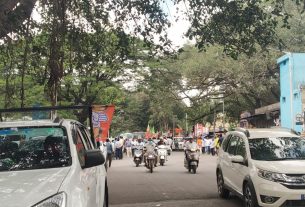An Election Commission official answered the Supreme Court’s questions on the EVM-VVPAT today.
The Supreme Court reserved the verdict in the Electronic Voting Machine-Voter-Verifiable Paper Audit Trail (EVM-VVPAT) case today. The bench comprising Justices Sanjiv Khanna and Dipankar Datta was hearing petitions seeking 100 percent EVM-VVPAT verification.
The Supreme Court called up an Election Commission official to answer technical queries regarding EVM-VVPAT verification at 2 p.m today. However, Justice Khanna clarified that this was not a rehearing and that the bench only had a few additional queries.
The bench posed questions regarding the programming of the microcontroller installed in the EVMs, storage of EVMs and VVPATs, and the maximum period for which they will be retained, The Hindu reported.
Responding to Prashant Bhushan’s question about the possibility of EVM tampering, Justice Dipankar Datta said that such incidents have not been reported and asked, “Can we issue a mandamus on suspicion?” Justice Sanjiv Khanna remarked, “The Supreme Court cannot control the elections.”
Microcontroller
To the Supreme Court’s query whether the microcontrollers installed in the EVMs were “one-time programmable”, the EC official explained that they are one-time programmable and cannot be accessed physically. All three units of the EVMs have their own individual microcontrollers and are housed in secure modules, he said.
However, senior advocate Prashant Bhushan appearing for the petitioners expressed his doubt about the processor chip in EVM being one-time programmable. “This microcontroller has a flash memory also. So to say that the microcontroller is not reprogrammable is incorrect,” he said.
Storage of VVPAT
VVPATs and EVMs are stored separately before polling, and are stored as a unit after the polling, said the EC official. “After polling all three units of the EVMs are sealed,” he said. He was answering the court’s question on how the VVPATs and control units are stored.
Symbol loading units
The EC official informed the apex court that the Election Commission of India has over 5000 symbol loading units. “The ECI has two manufacturers for symbol loading units – Electronics Corporation of India Limited (ECIL) and Bharat Heavy Electricals Limited (BHEL). The manufacturer may need over a month to get more such units depending on the availability of the components,” he said. The court had enquired about the number of symbol loading units available with the ECI.
Preservation of VVPAT slips
The ECI preserves the EVMs and VVPATs for 45 days after polling. After this period, the Chief Electoral Officer writes to High Courts to find out if there are any election petitions. If not, they are taken out of storage, said the EC official. He was clarifying to the court about the period for filing election petitions and the corresponding period for preserving VVPAT slips.
The bench had previously interacted with senior Deputy Election Commissioner Nitesh Kumar Vyas to understand the functioning of EVMs. Senior advocate Maninder Singh, appearing for the Election Commission, had said that while EVMs cannot be tampered with, the possibility of human error cannot be dismissed.
The petitioners, including the Association for Democratic Reforms (ADR), had said that people had a right to a more transparent electoral system. The Supreme Court, however, had earlier ruled out the possibility of returning to paper ballots, calling it a “humongous task.” The court said that machines provide accurate results unless tampered with.
The ADR, a Non-Governmental Organization (NGO), is one of the petitioners who have sought a reversal of the Election Commission’s 2017 decision to replace the transparent glass on VVPAT machines with an opaque glass, through which a voter can see the slip only when the light is on for seven seconds, News18 reported.
What is VVPAT?
The VVPAT system is connected with the EVMs and provides the voter with a paper trail to verify that their vote was cast as intended. The VVPAT slip consists of a serial number, name, and symbol of the candidate for whom the vote has been cast. The slip is visible for about seven seconds before it gets dropped in the sealed VVPAT box. No voter can take a VVPAT slip back home. VVPAT slips are used to tally the results from the EVMs.
Currently, VVPAT slips are verified from five randomly selected EVMs of each Parliamentary constituency. The petitioners call for full cross-verification of every vote in each assembly.
Steffy Maria Paul and Ishika Sharma contributed to this story.



